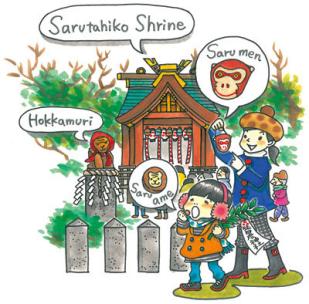Hakata Culture vol.48
Monkey masks on the front door---an old Hakata tradition

The quiet and secluded Sarutahiko Shinto shrine stands in front of the Fujisaki Bus Terminal in Fukuoka City’s Sawara Ward. It’s usually empty of parishioners or visitors, but on a few days out of the year it’s the destination of a lively crowd. The first of those days is known as Hatsukoshin, and comes early in the new year. It is a moveable festival day, and next year it will be on Wednesday, January 5. At five a.m., well before dawn, people will ring the shrine grounds to wait for the office to open. They’re lining up to buy the lucky charm that will go on sale that day-a monkey mask.
Sarutahiko, the enshrined deity, was the divinity of legend that guided Ninigi no Mikoto to earth to pacify Japan on the instructions of Amaterasu. Since then, he has been known as the divinity of roads, travelers, and guidance. The word monkey in Japanese is saru, which is a homonym for saru, or the verb to depart. From that association, Hakatans have long hung monkey masks on their front doors so that fires and thefts will depart. Walking through old Hakata, you’ll see monkey masks hung as a decoration next to the residential nameplates on which are written the duties performed by the residents in the Hakata Gion Yamakasa.
The masks are made individually by hand, and if you look carefully you can detect subtle differences of expression. The old masks are replaced by new masks every year, and there are slight changes in design. Some mask aficionados display all the masks from years gone by. There are monkey-themed decorations in several locations on the shrine grounds, and on the day of the Hatsukoshin, the monkeys are adorned with red tenugui towels as head coverings. The shrine also sells the saru-ame confection only on this day. It resembles the familiar Kintaro-ame with a monkey face instead of the Kintaro character.
In a take-off on the well-known Japanese proverb, “Even monkeys fall from trees” (i.e., even experts sometimes make a mistake), many students have begun buying the masks in the hope of passing their examinations. They hope to become monkeys who do not fall from the trees. It’s all worth getting up early for on January 5.
The shrine office opens at 5:30 a.m. and closes at 7:00 p.m., but be sure to get there early before they sell out. The masks sell for 1,000 yen apiece. For inquiries, call the Momiji Hachiman-gu at (092) 821-2049.
On your way back, be sure to stop by the nearby Takatori commercial district, where shops offer free tea to people on their way home from the shrine starting at 7:00 a.m.
猿のお面を玄関に飾るのが博多の習わし
福岡市早良区の藤崎バスターミナルの前に、ひっそりとたたずむ小さな猿田彦(さるたひこ)神社があります。いつもはお参りする人もいない閑散とした神社なのですが、年に何度か大にぎわいを見せる日があります。年明けて最初ににぎわうのが「初庚申(はつこうしん)」の日。この日は毎年異なりますが2011年は1月5日(水)、日の出前の早朝5時半には、境内をぐるりと人が囲み、社務所が開くのを多くの人が待っています。何を待っているかといえば、そこで売られる縁起物のお面、猿面です。
神社の祭神・猿田彦というのは、天孫降臨の際にニニギノミコトを道案内したという神さまで、それ以来、道の神、旅人の神、導きの神、道案内の神さまとして親しまれているとか。さらに猿は「去る」に通じて、火難や盗難を防ぐとされ、博多っ子は玄関にこのお面を掛けてお守りにしています。博多部を歩いていると、博多祇園山笠の役割(総務とか赤手拭いなど)を書いた表札の隣にこの猿面が飾られているのを見ることができます。
この猿面ですが、ひとつひとつ職人さんの手作りだそうで、よく見ると表情が微妙に異なります。毎年新しいお面と古いお面を掛け替えるのですが、少しずつデザインも異なるようで、毎年のお面をずらりと飾っているツウの人もいるようです。境内には猿の飾り物が何個か置かれていますが、初庚申の日にはこの猿たちが赤い手拭いでほっかむりをしています。これがまた愛嬌があって可愛いのです。可愛いといえば、この日しか買えない名物「さるあめ」。金太郎飴の猿版です。
近頃では、猿は木から落ちないことから、合格祈願のお守りとして購入する人も多いと聞きました。1月5日は頑張って早起きしてみましょう。社務所が開いているのは5時半から夜19時までですが、売り切れることは必至ですよ。猿面は1体1,000円。問い合わせは紅葉八幡宮(Tel.092-821-2049)
近くの高取商店街では、参詣帰りの方たちに向け、朝7時から無料でお茶のサービスをしているとか。足を伸ばしてみませんか。

